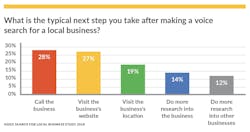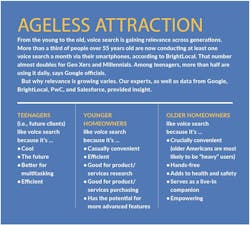Half of all online searches will be spoken in less than two years, experts say. It’s going to transform SEO on a cellular level, and while users may not notice the changes so much, businesses will. The question is not, “Is your business ready for the change?” but rather, “Is any business ready for it?” Being able to say “yes” could be the difference between seizing the opportunity and having it step on you.
Good news is, we have an idea where the shoe is falling.
“In terms of SEO and actual (marketing) campaigns themselves, keywords are where we’re going to see the most dramatic shift,” says Karen Nelson, marketing manager for Keyword Connects, a company that specializes in online advertising for home improvement companies. “Just think of how you say something versus how you type.”
The field of speech recognition goes back decades. Dictation software became available in the early '80s, and by the late '80s the technology was developed and widespread enough to start showing up in kids’ toys. Its internet debut, though, came later, in 2008, when Google introduced Voice Search for iPhone. It was the first taste of being able to literally ask Google something. The problem was Google had trouble understanding what people wanted to know.
The average word error rate of human beings is 5%—meaning we misunderstand 5% of the words people speak to us. In 2011, Google’s word error rate was 26%—one in four words wrong. It stunted voice search adoption. Only 11% of the people using voice search in the U.S. today were using it three years ago, according to a survey of 1,800 adults by voice search technology company MindMeld.
But obviously Google got better.
By 2016, the search engine’s word error rate was down to near 8%. The following year, 4.9%. Today, Google is better at interpreting words than the people who speak them.
Voice search is now standard on most smartphones, and functionality extends far beyond navigating the internet. It currently accounts for 20% of all mobile searches, which, in turn, account for half of total searches, said Google CEO Sundar Pichai during his keynote at the annual Google I/O conference. Leading media measurement and analytics company comScore projects that by 2020, half of all online searches, across all variety of devices, will be spoken. Today, four in 10 adults use their phone to do a voice search daily, according to Google.
With Scale Comes Impact
In order to really understand voice search, you need to know about RankBrain, says Chris Behan, owner and chief optimization officer for Socius Marketing.
“It’s a mobile-driven, AI-based algorithm that pools a bunch of Google info to understand user intent,” Behan says.
More specifically, RankBrain helps Google understand queries it hasn’t already received, and to, in the immediate, determine relevant results for those queries, while, in the long term, using that information to continually refine search engine results pages (SERPs). Google says that among the hundreds of algorithms it uses to assign page rankings, RankBrain is the third weightiest factor (behind backlinks and quality of content). But the rise of voice search could boost its import.
“If I want to ask Google about buying new windows, there are about 150 different ways for me to ask that,” says Josh Strupp, associate director of marketing for digital ad company iStrategyLabs, or ISL.
Basically, voice search’s biggest expected impact on SEO, at least in the short term, is that queries are going to start conforming to speech patterns rather than typing patterns, accelerating an already-happening shift in relevance from short-tail to long-tail keywords.
Short-tail keywords are singular, or exceptionally short, between one and three words. It’s like if a roofer wanted to be found on Google, he or she might think adding “roofer” or “roof repair” (or some variation) to the company website will help boost visibility. It’s an old way of looking at SEO, when keywords were king—before ad companies made targeting them so competitive. “Burying keywords in content died a couple of years ago,” Behan says.
Long-tail keywords are four- to six-word phrases and often appear as questions, such as, “Where’s a roofer in my area?” According to experts, those are the keywords of the future. Today, the top 10,000 short-tail keywords make up less than 20% of all search traffic, according to SEO company Moz. The rest is long-tail.
Understanding Usage
If voice search accounts for 20% of all mobile searches, and mobile searches account for half of total searches, then mobile voice searches currently account for 10% of total searches. Google processes upwards of 3.5 billion searches a day, so about 350 million of them are spoken.
That’s a nice figure to illustrate the current ubiquity of voice search, particularly through mobile devices. But it doesn’t show how people use voice search.
In a survey of more than 1,000 U.S. consumers, SEO tools provider BrightLocal aimed to shed light on that very question. It found that 58% of voice search users, who primarily search via smartphone (56%), but also by tablets (28%) and smart speakers (18%), have used voice search in the last 12 months to find information on a local business. About half say they’re asking for that information daily, regardless of device (though it’s most common among smart speaker users [53%]).
Consumers want to know pretty much what you’d expect: hours, location, phone number, and—more surprisingly—reviews, which might very well grow in popularity. Nearly half of respondents said they’d be willing to try finding reviews via voice search in the future.
Something to keep in mind is that most queries involve a business that users already know. In its report, BrightLocal writes that “(voice) searches are less likely to use the technology for business discovery purposes.”
As it pertains to remodelers and home improvement companies, the trend of using voice search for local business information is particularly important: 46% of searchers are looking for prices on services, 41% are trying to find out what services a business offers, and 23% are specifically looking to hire a tradesperson. The trend of using voice search to hire home services companies has already caught Google’s attention, which rolled out a special feature on its Assistant late last year designed to improve the ease with which users can request information on tradespeople and related companies. It’s a blend of quick-access information and prompts that guide the user in specifying what kind of work they need done. Data from BrightLocal, seen below, shows that what follows voice querying a local business tends to be the user sliding further down the sales funnel. It supports the notion that optimizing for voice search can be an effective lead generation engine.
Strupp predicts a slow adoption for voice search being used to make sales, particularly through smart speakers. Research from NPR and Edison Research found that 57% of smart speaker owners have made at least one purchase through their device. However, nearly 90% of purchases were under $200.
Translating To SEO
Tweaks to Google’s page ranking algorithms are not that uncommon. There’s been about a dozen this year already. The big changes are less common. Anyone even peripherally familiar with the history of SEO will remember Google’s August 2013 Hummingbird update, which popularized the term “semantic search” and effectively prioritized quality content over keyword stuffing. It changed the Internet.
Although it’s not a change to Google’s algorithm, the ultimate impact of voice may be similarly profound. “Businesses, small and large, need to pay attention to this,” Strupp says. “And the big thing remodeling and home improvement companies are going to have to plan for is utterances.”
An utterance is another word for a request, or long-tail keyword. Planning for possible utterances is, by a mile, the best thing a remodeler or home improvement business can do to optimize its website for voice search, at least right now, according to not just to Strupp, but also SEO veterans Nelson and Behan.
“Businesses need conversational content,” says Behan, whose company Socius has already helped a few home improvement companies in this regard. “They need content that asks questions and then answers those questions on the same page.”
Still, it’s not an exact science. Even Google is finding that after processing trillions of queries, it’s still being caught unawares. The experts are looking for workarounds.
“You can find clues to possible questions clients will ask in SERPS,” Behan says. Things like Google’s “featured snippets” and “People also ask” (seen on the right) sections—both found just below the search bar and any paid results—give business owners a peek at the tendencies of potential clients. Ask Google, “How much is a kitchen remodel?” and assuming you’re still on a screened device, you’ll see a featured snippet and below that a series of questions RankBrain has determined are similar to the original query. “The more we looked at the questions being asked, the more we see the journey of who, how, when, etc.”
If the user is asking through a smart speaker, which is to say a device without a screen, the featured snippet is what the interface reads back.
Tools And Considerations
There are SEO specialists, like ISL, Socius, and Keyword Connects, that can help businesses determine what questions to ask and how. There are also tools.
Rank Tracker, for instance, is an SEO software that includes a “common questions” feature, which suggests possible long-tail keywords based on short-tail keywords. So from the keyword “kitchen remodel,” it will generate who, what, when, where, and how questions that people are already asking online. The same is true for the web tool AnswerThePublic. It’s more bare bones than Rank Tracker, but in terms of generating long-tail keywords from short-tail ones, it fulfills the same function.
Keyword Connects' Nelson says that a company can further refine the questions and answers it includes in its content by better understanding the demographics of its market. “Your market defines your marketing. When you know your territory better, you market better,” she says.
Young people are more likely to use voice search than any other demographic, for instance. Citing Keyword Connects proprietary data, Nelson adds that young people also search for particular types of home improvement jobs. “They’re more interested in interior design and making their homes smarter, particularly their kitchens,” she says. The idea is that if you’re an interior designer operating in an area with a large Millennial population, you should optimize your site for voice search (and mobile, if you haven’t already).
But it’s not just young people, says Nelson, Behan, Strupp, and Google’s head of conversation design outreach, Cathy Pearl.
Behan says that optimizing for older consumers using voice search is something his company is already doing. “It is popular with the 50- to 60-year-old demographic. That’s where it’s growing fastest. They don’t want to pound out search queries into their phone.”
Nelson says that smart speakers have become part of the aging-in-place trend.
The popularity of smart speakers among older homeowners will make featured snippets an important tool for connecting with them—and doubly so because featured snippets effectively act as a vacuum, pulling leads into the sales funnel. Content in a featured snippet can have click-through rates up to twice that of other content not in the same position, a report from HubSpot showed.
It’s Going To Get Easier
Strupp says that optimizing methods are bound to get better. “Just like there were web frameworks that adapted to Google to create web structures built around the purpose of better SEO, I think there’ll be the same for voice search.” He talks about building a website, or creating any sort of digital experience, and how there’ll be extensions with built-in fields to ensure the site is optimized for voice search. “There’s going to be more and more tools at our disposal, enough that we won’t have to worry about voice search so much.”
About the Author

James F. McClister
James McClister is managing editor for Professional Remodeler.





